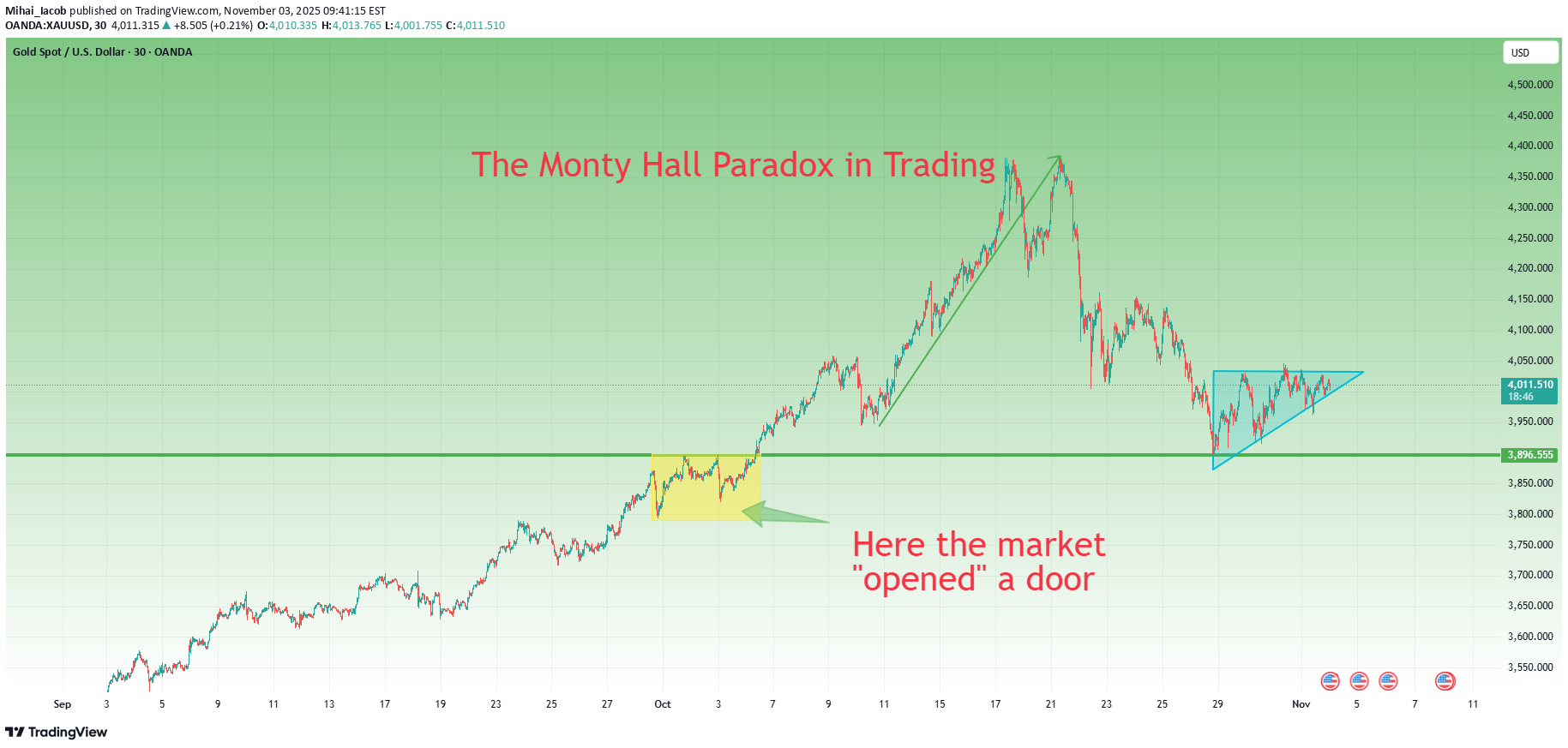Technical analysis by Mihai_Iacob about Symbol PAXG on 11/3/2025

Mihai_Iacob
تله ذهنی معاملهگران: پارادوکس مونتی هال چگونه سود شما را میبلعد؟

Most traders think the Monty Hall paradox has nothing to do with markets. But every time you refuse to change your bias — it plays out right in your chart. At the beginning of October, I started looking for signs of a drop in gold. They came very late. Instead, from October 1st, gold rallied more than 5000 pips before dropping. I was aware of the Monty Hall paradox — and yet, I didn’t switch. And this post is not about why I didn’t switch. It’s about understanding the paradox itself, and how it quietly plays out in trading every single day. Because yes — gold eventually dropped, and it dropped hard. But before falling 5,000 pips, it first rose 5,000 pips — and before that rise even began, the market clearly opened a door just before breaking above 4,000 pips — a door I chose to ignore. That’s exactly what this article is about: recognizing when the market opens new doors, and understanding why switching — just like in the Monty Hall paradox — often gives you the better odds. 🎭 The Original Paradox The Monty Hall problem comes from an old game show called "Let’s Make a Deal ". There are three doors: behind one is a car, and behind the others are goats. You pick one door. The host, who knows what’s behind them, opens another door — always showing a goat. Then he asks: “Do you want to stay with your first choice or switch?” Most people stay "No" But mathematically, you should switch — because the probability of winning jumps from 1/3 to 2/3 after that reveal. The host didn’t change the car’s position — he changed the information you have. And that’s what makes all the difference. If you’ve never heard of the original paradox, you might remember it from the film "21" with Kevin Spacey — the scene where he teaches probability through deception, using the Monty Hall setup to show how humans instinctively trust their first choice. That’s exactly what markets do: they give you partial information, make you feel confident, and then quietly shift the odds while you’re still defending your initial pick. 📊 The Trading Version In trading, there are no doors — only biases. But the logic is identical. When you open a trade, you’re making a probabilistic choice based on incomplete data. You think it’s 50–50 — up or down — but it’s not. You’re guessing direction, but also timing. In reality, your initial bias might have a 1/3 chance of being fully correct. Then the market — our version of Monty Hall — reveals new information: a failed breakout, a strong reversal candle, a macro shift, a sudden volume surge. That’s the door opening. And now you face the same question: “Do you stay with your first choice or switch?” 🧠 Why Most Traders Don’t Switch Because switching feels like admitting you were wrong. Ego and attachment to our analysis make us defend our initial position, even as evidence piles up against it. But the market doesn’t reward stubbornness — it rewards adaptation. Refusing to switch isn’t strength; it’s emotional inertia. 🔁 What “Switching” Really Means It doesn’t always mean reversing your trade. It can mean: - Cutting your loss early instead of waiting for stop loss - Closing a position that started “right” but begins behaving wrong. - Flipping your bias when the structure proves you wrong. - Or simply, pausing — accepting that the setup no longer fits the data. In each case, you’re doing what the smart contestant in Monty Hall does: You’re updating your probabilities as new information arrives. 💬 The Lesson The paradox isn’t about doors — it’s about humility. About understanding that the first choice you make in trading could end up not being the best one. The best traders don’t need to be right. They need to be flexible enough to become right later. So the next time the market “opens a door” — don’t get defensive. Recalculate. Reassess. Sometimes, switching is the only way to stay in the game. 🚀 Closing Thought The Monty Hall paradox isn’t about luck; it’s about using information wisely. The same rule applies to trading: If the market gives you new data, use it — even if it means admitting your first bias was wrong. Because the moment you stop defending your first choice, you finally start trading with probability — not pride. P.S. Although I did manage to make some profit on short trades, that’s beside the point. What truly matters is that the market clearly opened a door at the beginning of October — and even though I saw it, I ignored it. Yes, the market eventually dropped as initially expected, but that too is beside the point. This isn’t about being right in the end; it’s about recognizing when the market opens new doors and having the courage to walk through them.